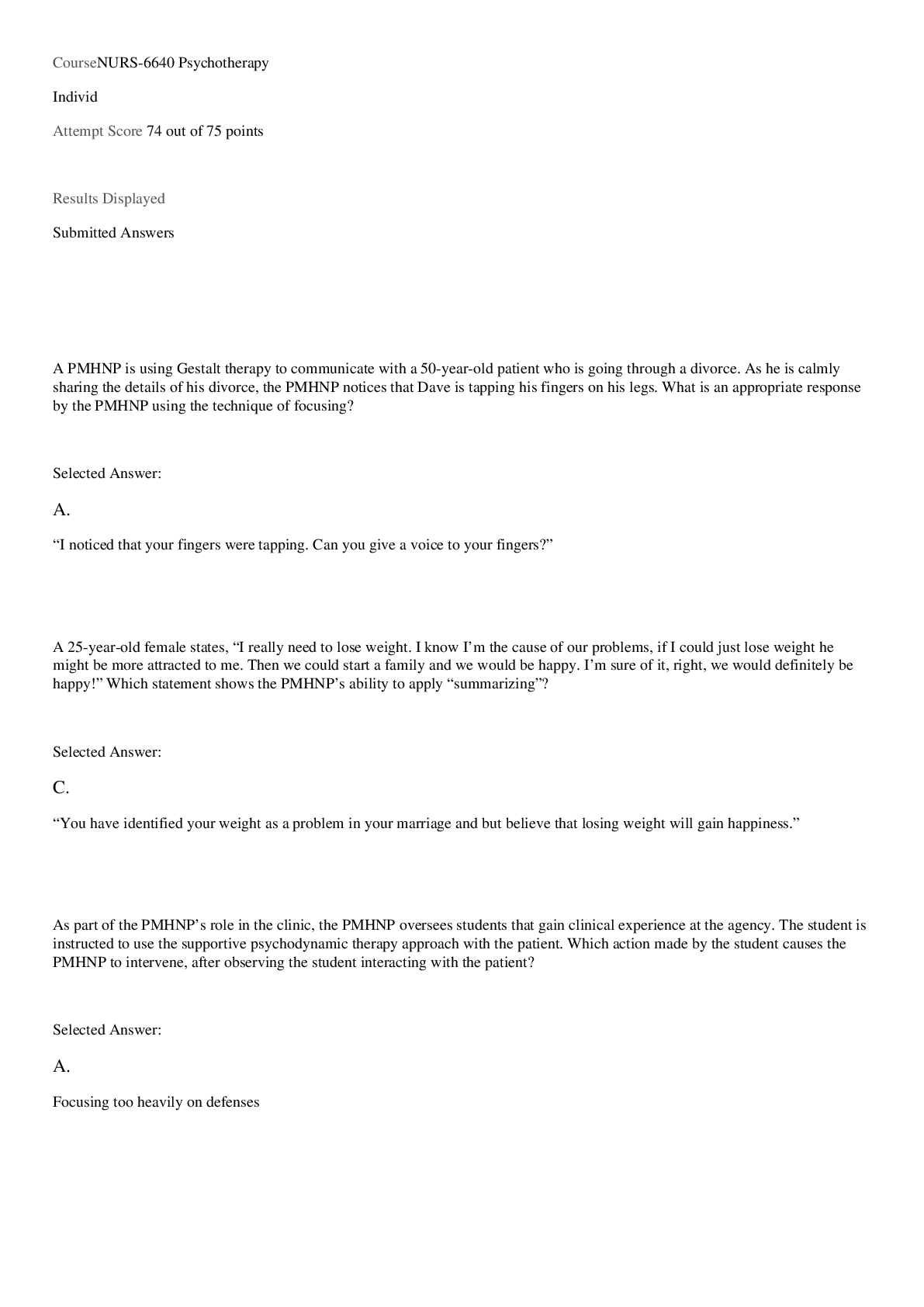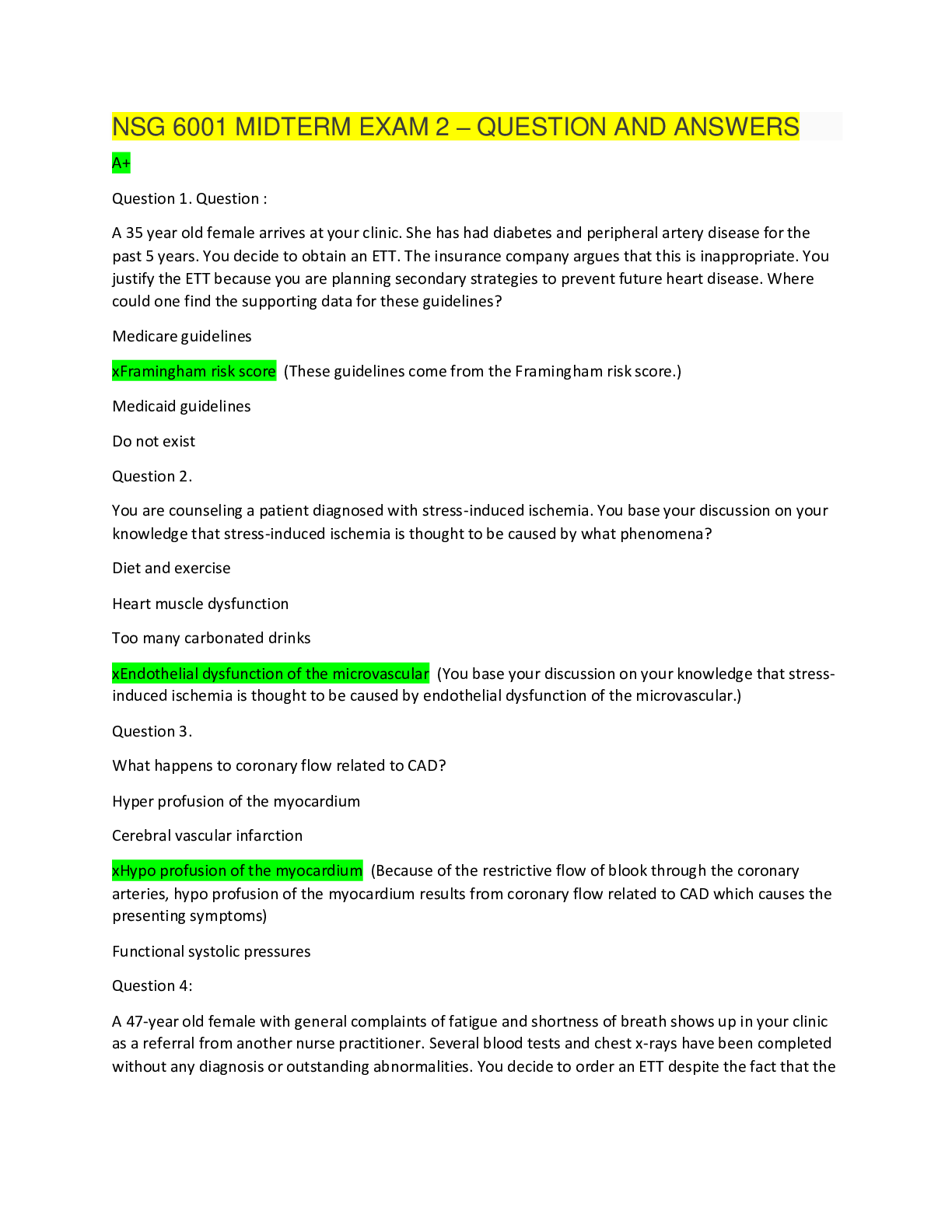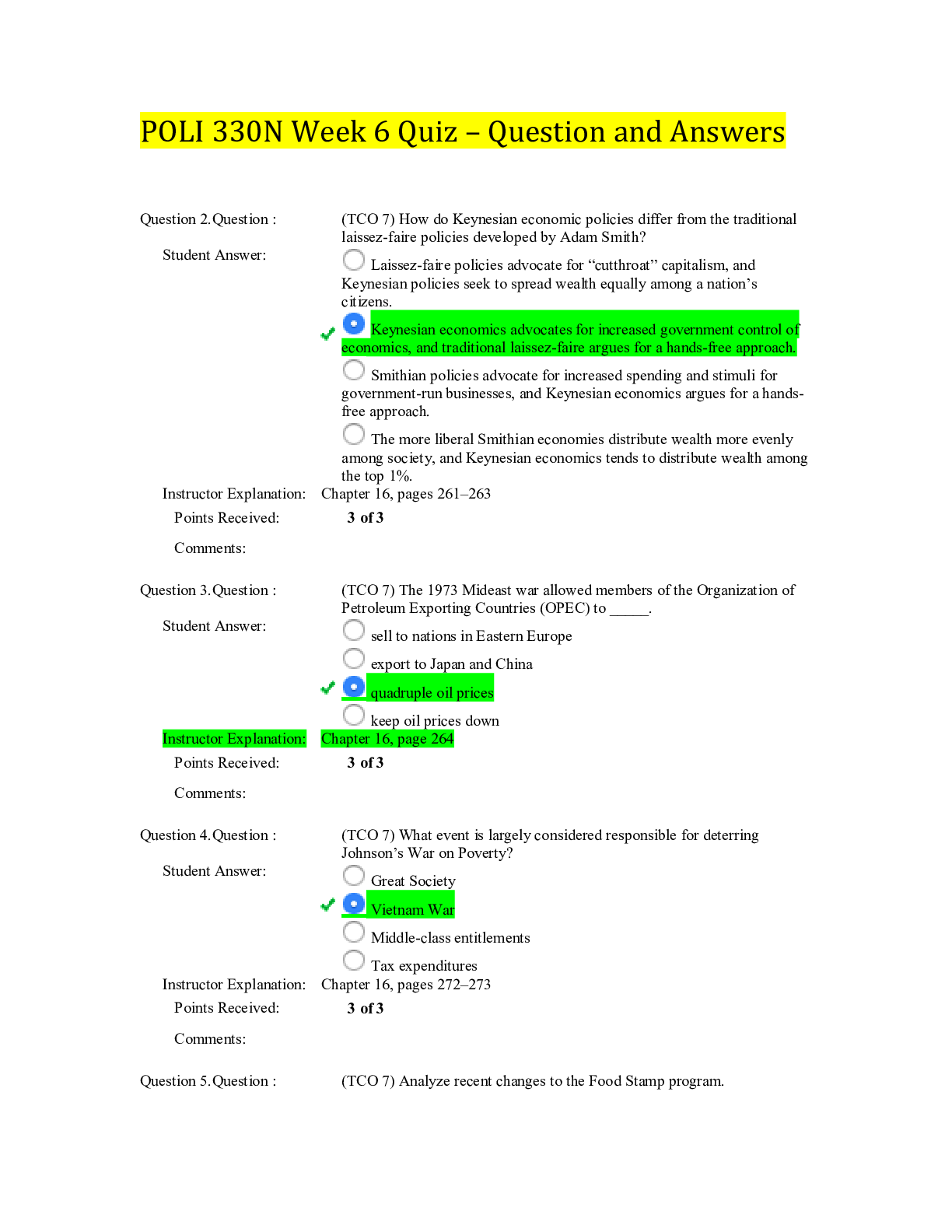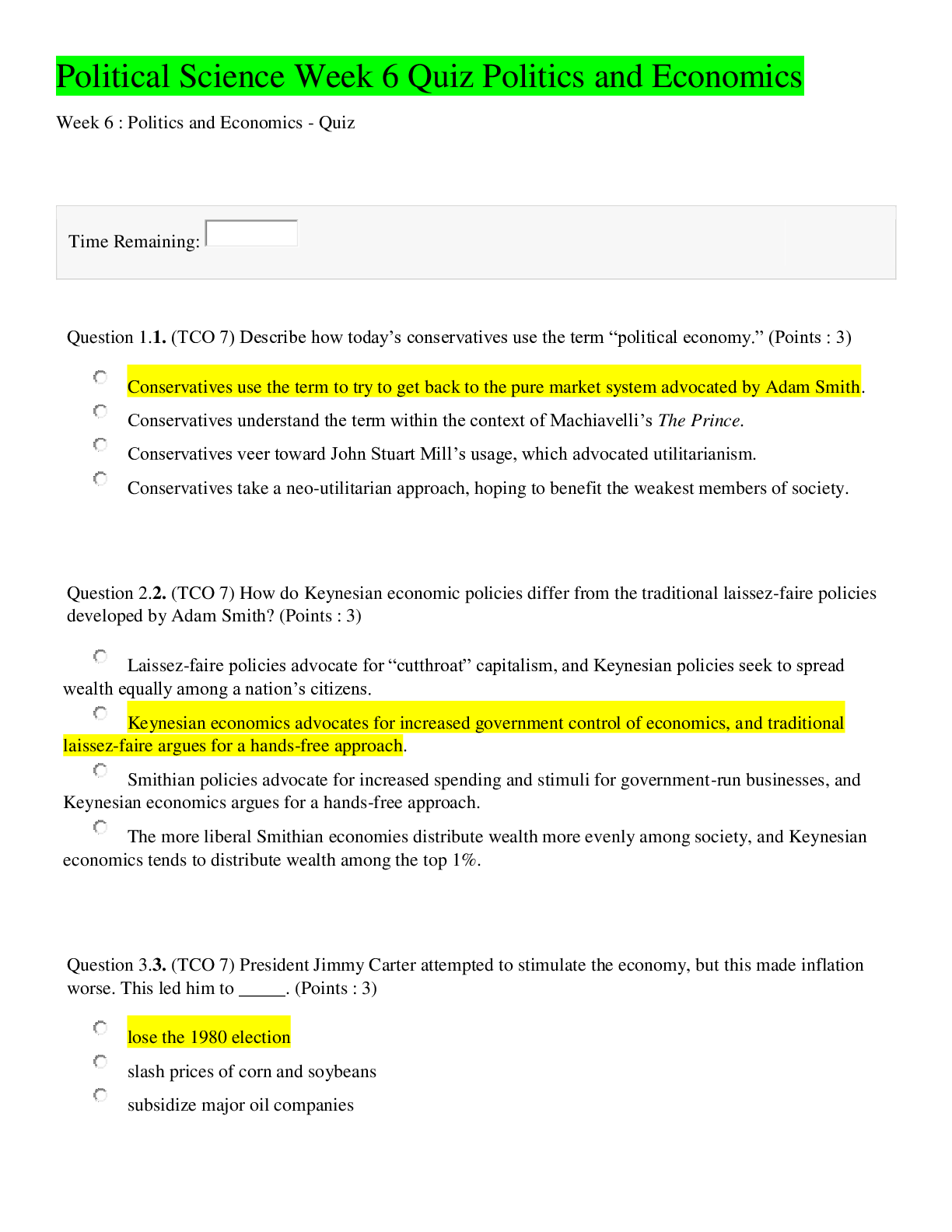Health Care > EXAM > NURS 6640 FINAL EXAM 6 – QUESTION AND ANSWERS (All)
NURS 6640 FINAL EXAM 6 – QUESTION AND ANSWERS
Document Content and Description Below
The PMHNP is caring for a young adult patient with whom the PMHNP decides to use a dynamic supportive therapy approach in addition to pharmacological intervention. Which therapeutic action will the PM... HNP take to employ the strategy of holding and containing the patient? A 21-year-old patient has been having trouble adjusting to college life. She tells the PMHNP that she had five alcoholic drinks at a party this past weekend. She also acknowledges that she drank the same amount of alcohol at a party the previous month. Based on this information, what would the PMHNP most likely recommend? A PMHNP is treating a 10-year-old boy who is exhibiting signs of aggression and attention problems. What type of intervention will the PMHNP consider using a common elements approach? As part of the PMHNP’s role in the clinic, the PMHNP oversees students that gain clinical experience at the agency. The student is instructed to use the supportive psychodynamic therapy approach with the patient. Which action made by the student causes the PMHNP to intervene, after observing the student interacting with the patient? A 43-year-old single mother is seeing the PMHNP at the request of her sister. “My sister thinks I need to come here to talk about my feelings,” the patient reports. The PMHNP learns that the patient has three children from three different men, but is unable to collect appropriate child support payments from any of the biological fathers. Additionally, the woman is barely able to afford her apartment or utilities payments. What is the appropriate response from the PMHNP when using the psychodynamic psychotherapy technique? An 8-year-old has been having trouble making friends at school. His parents initiated treatment when he also started acting out at home. Which is the most appropriate step that the PMHNP takes during the assessment process when using an integrated approach? Following an attempted suicide, Mr. Durham was admitted to an acute psychiatric facility. After 4 weeks in treatment, he is preparing for discharge. He is beginning to miss individual and group therapy sessions and has refused medications twice in the past 2 days. The PMHNP demonstrates understanding in this phase by saying which of the following statements? A cocaine-addicted female patient is entering residential treatment for substance abuse. Using the 10 guiding principles of recovery, an appropriate step by the PMHNP is to ______________. A PMHNP is treating a 25-year-old patient who has a compulsive urge to exercise to excess. When asked to describe why she does so much exercise, she says, “I like the compliments I receive from others on my new level of fitness, and the excitement of getting more attention.” The PMHNP can use feeling-state therapy to help Monique ___________. While assessing a patient using a humanistic-existential approach, a patient tells the PMHNP, “For the past few weeks, I’ve felt anxious almost every single day.” What would be an appropriate next step by the PMHNP? A PMHNP is using interpersonal psychotherapy with a 40-year-old patient having relationship problems with his extended family. The patient shares that he has been using the strategies they identified to reduce his distress, but they have not been helping. He is frustrated and is considering stopping treatment. What would be an appropriate step by the PMHNP? The PMHNP is initiating a plan of care for Holly, a 73-year-old female patient who has late-life bipolar disorder and reports consuming alcoholic beverages four times per week. What is the focus of Holly’s therapy going to be? A PMHNP is treating a 12-year-old girl who witnessed the physical abuse of her sibling. She has been anxious and irritable since the experience. After speaking with the PMHNP, the patient says she keeps having anxiety-causing thoughts about the experience. Using the PRACTICE technique, which skill will best help the patient interrupt these negative thoughts? The PMHNP has been providing interpersonal psychotherapy (IPT) for a patient who the PMHNP observes implementing new ways of being, such as interacting more with peers and being less isolated in social scenarios. The PMHNP understands that the patient is approaching termination. How does the PMHNP address termination with this patient? When preparing to terminate a patient, what does the PMHNP do to organize thoughts about the patient’s progress made during treatment? The PMHNP is working with a patient who describes having a painful and traumatic childhood experience, which causes her to have anxiety as an adult. When asked how she manages her anxiety, the patient dismisses it and denies that it is a problem. Using the supportive psychotherapy approach, the PMHNP will do which of the following when assessing the patient’s ego strength? In the planning phase of change, a 42-year-old male client who struggles with gambling discusses how he plans to abstain from gambling. He tells the PMHNP, “I am no longer going to carry cash to the casino because you can’t spend what you don’t have.” The PMHNP uses an affirming communication skill when she states: The PMHNP is initiating a plan of care for a patient who requires comprehensive psychotherapy to manage his depression and mood disorder. Throughout the initial sessions, the patient reports feeling as though he cannot be helped. The PMHNP is concerned about premature termination initiated by the patient. What strategy can the PMHNP employ to prevent or reduce premature termination? A 19-year-old female patient named Anna, who was the victim of child abuse and neglect, is also in treatment for substance abuse. At her most recent appointment, Anna confesses to the PMHNP that she is having romantic fantasies about him, and explains the he is one of the few people she trusts. She believes that he is interested in her as well. What is the most appropriate response by the PMHNP in this situation? The PMHNP continues to meet with Gerald, who is the patient with depression and mood disorder. The PMHNP uses the CBT approach. Gerald is now meeting with the PMHNP for his fifth session and feels comfortable with how the therapy works. What does the PMHNP plan to do with Gerald over the course of the next several sessions? A PMHNP is using Gestalt therapy to communicate with a 50-year-old patient who is going through a divorce. As he is calmly sharing the details of his divorce, the PMHNP notices that Dave is tapping his fingers on his legs. What is an appropriate response by the PMHNP using the technique of focusing? The PMHNP has been providing supportive psychodynamic psychotherapy to a patient and is nearing the termination stage. The PMHNP will use which criteria for determining that the patient is ready for termination? A PMHNP is using Gestalt therapy to communicate with a 42-year-old patient who is upset with her mother. She says, “I want to tell her how hurt I feel when she doesn’t call me, but I don’t want to upset her.” What technique can the PMHNP use to help Sasha express herself? The PMHNP is terminating treatment with a patient who is aggressive and has a history of anger. What does the PMHNP do when terminating treatment with this patient? The PMHNP is assessing a patient who has been receiving months of outpatient psychotherapy. According to the PMHNP’s assessment, the patient is nearing the termination phase of their therapeutic relationship because the patient’s symptoms have improved, and the patient shows progress managing behaviors and decision-making abilities according to the diagnosis. How does the PMHNP approach termination with this patient? [Show More]
Last updated: 2 years ago
Preview 1 out of 17 pages

Buy this document to get the full access instantly
Instant Download Access after purchase
Buy NowInstant download
We Accept:

Also available in bundle (2)

NURS 6640 FINAL EXAM PACKAGE, 06 SETS (QUESTION AND ANSWERS)
NURS 6640 FINAL EXAM PACKAGE, 06 SETS (QUESTION AND ANSWERS)/NURS 6640 FINAL EXAM PACKAGE, 06 SETS (QUESTION AND ANSWERS)/NURS 6640 FINAL EXAM PACKAGE, 06 SETS (QUESTION AND ANSWERS)
By Bestnurse 4 years ago
$50.5
6

NURS 6640 MIDTERM AND FINAL EXAM – PACKAGE
NURS 6640 MIDTERM AND FINAL EXAM – PACKAGE/NURS 6640 MIDTERM AND FINAL EXAM – PACKAGE
By Bestnurse 4 years ago
$60.5
11
Reviews( 0 )
$17.00
Can't find what you want? Try our AI powered Search
Document information
Connected school, study & course
About the document
Uploaded On
May 12, 2021
Number of pages
17
Written in
Additional information
This document has been written for:
Uploaded
May 12, 2021
Downloads
0
Views
85







 17.png)
.png)

















